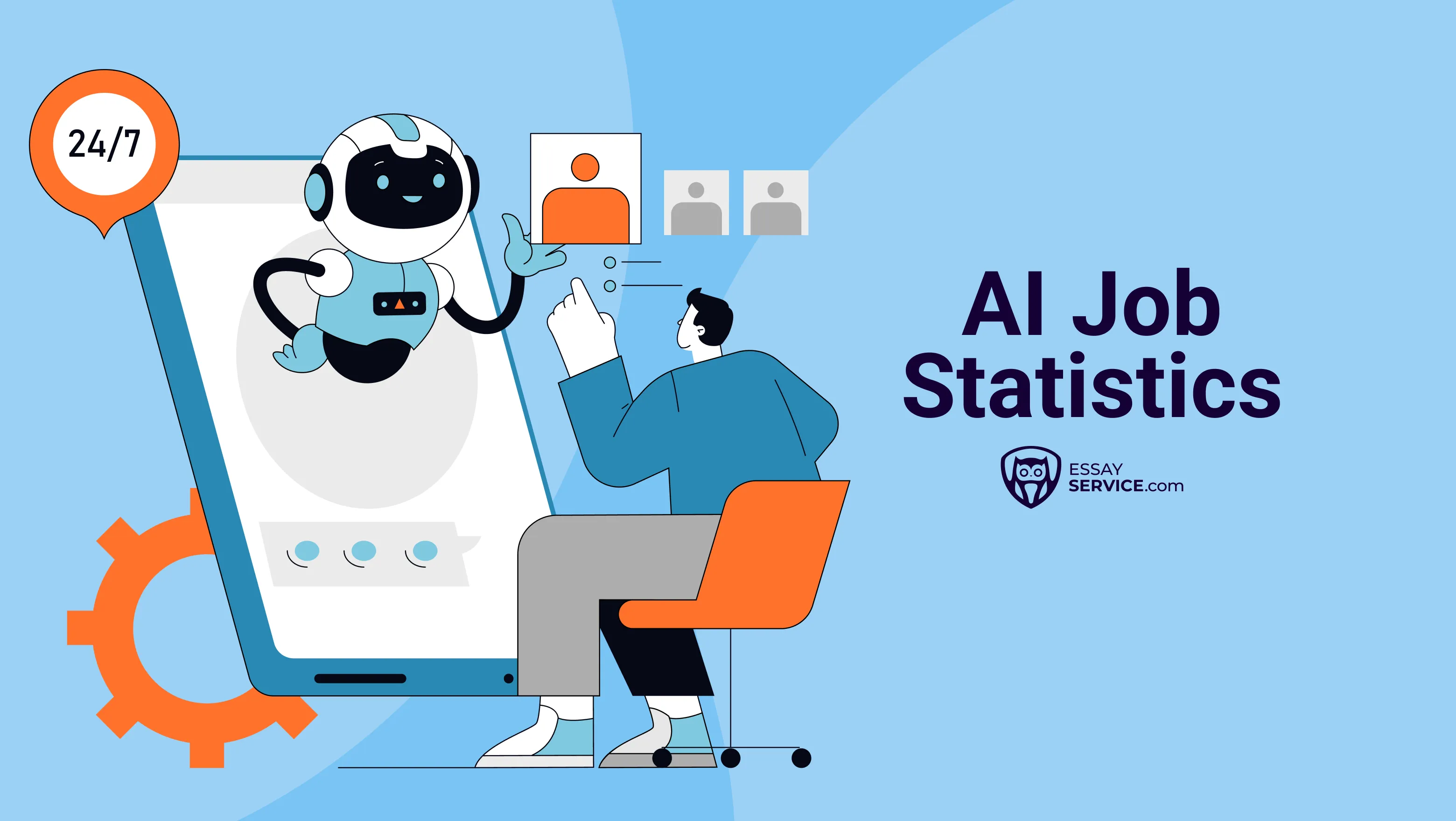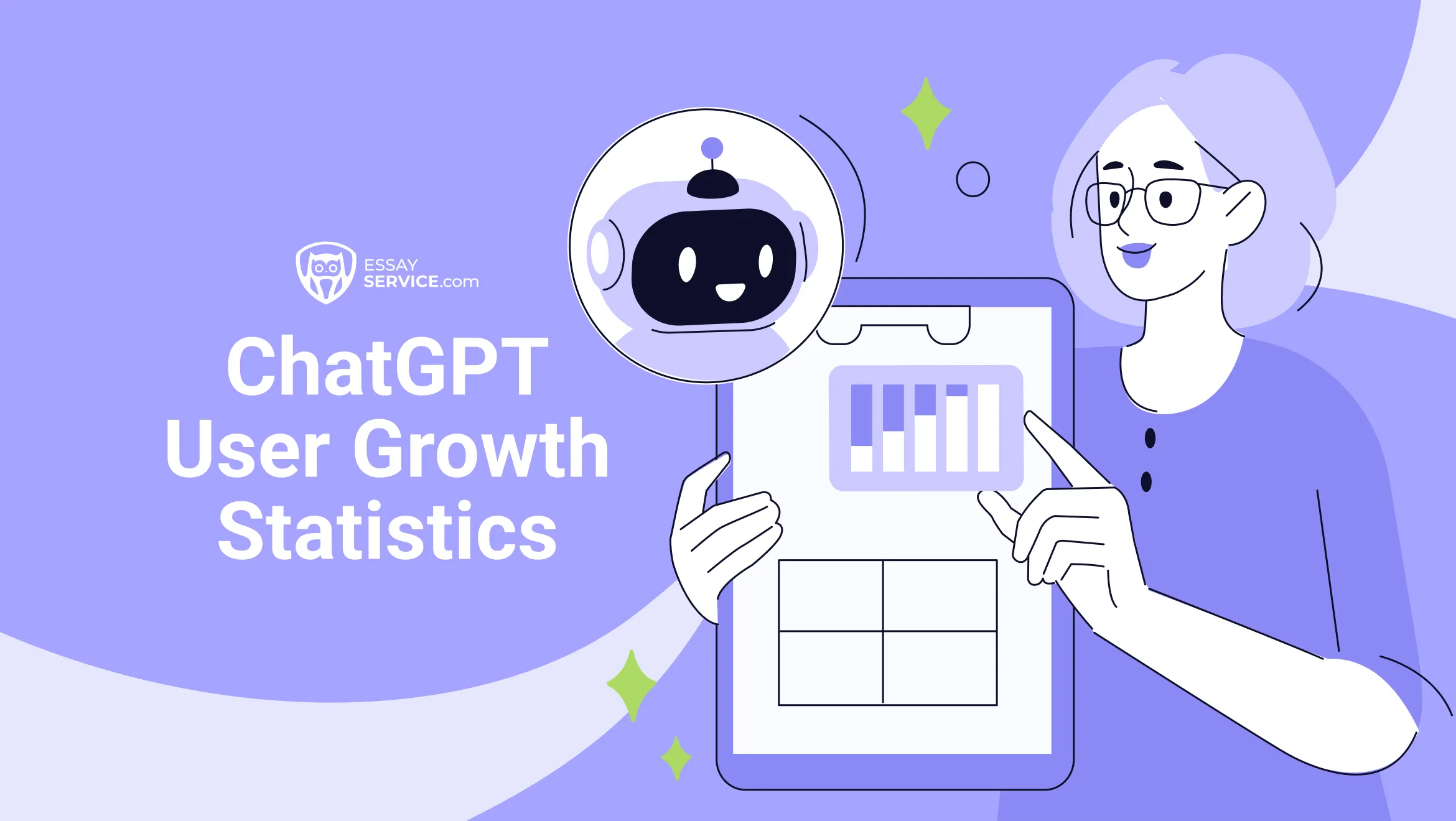Key Takeaways
- AI job loss statistics show that 30% of U.S. workers fear AI will take their jobs.
- 300 million jobs worldwide could be redefined or replaced by AI.
- 79% of women in the U.S. hold jobs at high risk of automation.
- 52% job growth projected for nurse practitioners by 2033.
- 56% higher pay earned by workers with AI-related skills.
Artificial intelligence is no longer a subject of science fiction and has moved into workspaces in every sector. In late 2024, more than 23% of employed U.S. workers were using generative AI tools at least once a week. Organizations are finding that AI integration can triple revenue per employee. Yet the statistics tell a more nuanced story. It’s true that some jobs will be automated, but AI tools augment or enhance tasks rather than replace occupations as a whole.
This article will try to answer the question - ‘will AI replace jobs?’ We will unpack the latest data on AI taking jobs and observe how students and recent graduates are feeling uncertain as the job market shifts and they enter the workforce.
As we explore the data behind AI’s impact on the current job market, remember that help is available. EssayService will help you stay grounded amid change, offering academic direction when navigating both your studies and the evolving world shaped by AI.

General AI Impact on the Jobs in The U.S.
The emergence of artificial intelligence, particularly generative AI tools, has become one of the most significant forces reshaping work today. What once felt remote and experimental is now creating real change in offices, factories, and classrooms. According to recent AI job displacement statistics:
- Nearly one-third of current U.S. jobs could be automated by 2030
- 60% of roles will see tasks modified by AI tools.
- 300 million jobs worldwide may be redefined or replaced.
- 25% of U.S. companies have already replaced some roles using AI.
- 40% of employers expect further workforce reductions due to AI.

Interestingly, much of Artificial Intelligence's growth is driven by workers, not executives. More than three-quarters of those using generative AI say they brought the tools into their workplace on their own, often to manage time better or cut through repetitive tasks.
AI continues to reshape how organizations function. However, the numbers only tell part of the narrative. While unemployment is shifting upward in specific jobs that are highly exposed to AI, most experts believe that technology rarely leads to job elimination of entire occupations overnight. According to the Bureau of Labor Statistics, job market AI shifts happen more slowly than expected. Jobs once predicted to vanish still exist because they depend on human judgment, regulations, and limits to automation.
Different Generational Views on AI in the Job Market
Views on AI replacing jobs differ considerably by age group. For instance, surveys show that workers aged 18-24 are 129% as likely as those over 65 to fear losing their jobs to AI. Many college students, especially those in Gen Z, worry that AI is reducing the value of a college degree. In addition, young workers are very enthusiastic adopters: 75% of knowledge workers use AI at work, which has rapidly grown over the last year.
Older generations are generally less enthusiastic about AI integration at work, yet they are also less worried about being replaced at work. Many individuals from older generations see Artificial Intelligence differently, as a tool for alleviating repetitive tasks and freeing up more time at work. For instance, 90% of workers using AI technology say that it saves their time. 85% of workers say that AI allows them to focus on tasks with higher value.
Overall, age influences how people see AI. Younger workers welcome it but worry about its impact, while older ones see it as a helpful tool, not a threat.
Gender Differences in AI’s Job Market Impact
AI adoption could amplify existing inequalities in the global workforce. A recent study found that 79% of employed women in the U.S. are positioned in jobs at high risk of being automated compared with only 58% of men. Globally, the gap is similar: in wealthy countries, 9.6% of women’s jobs and 3.2% of men’s jobs face major disruption. This gap exists because women often work in administrative, clerical, and customer service roles that Artificial Intelligence can easily automate.
One study found 58.87 million women, compared to 48.62 million men, held positions highly exposed to AI. In fields like personal finance, AI can handle tasks such as portfolio rebalancing, but personal financial advisors remain essential for planning and human connection. The BLS projects about 10% growth for advisors between 2024 and 2034, adding roughly 24,100 jobs per year, while clerical and administrative roles continue to decline.
Students and Their Perception of AI and the Job Market
As students get ready to enter the AI age, the labor market is both exciting and overwhelming. According to polls, 30% of U.S. workers are afraid AI will take their jobs, with this issue exceptionally prevalent among college students and recent graduates. Younger students are concerned that there will be no jobs when they graduate or that entry-level positions will no longer exist; estimates indicate up to 50 million entry level jobs are at risk. Plus, with high tuition and the rising cost of student debt, the overall value of a degree is called into question.
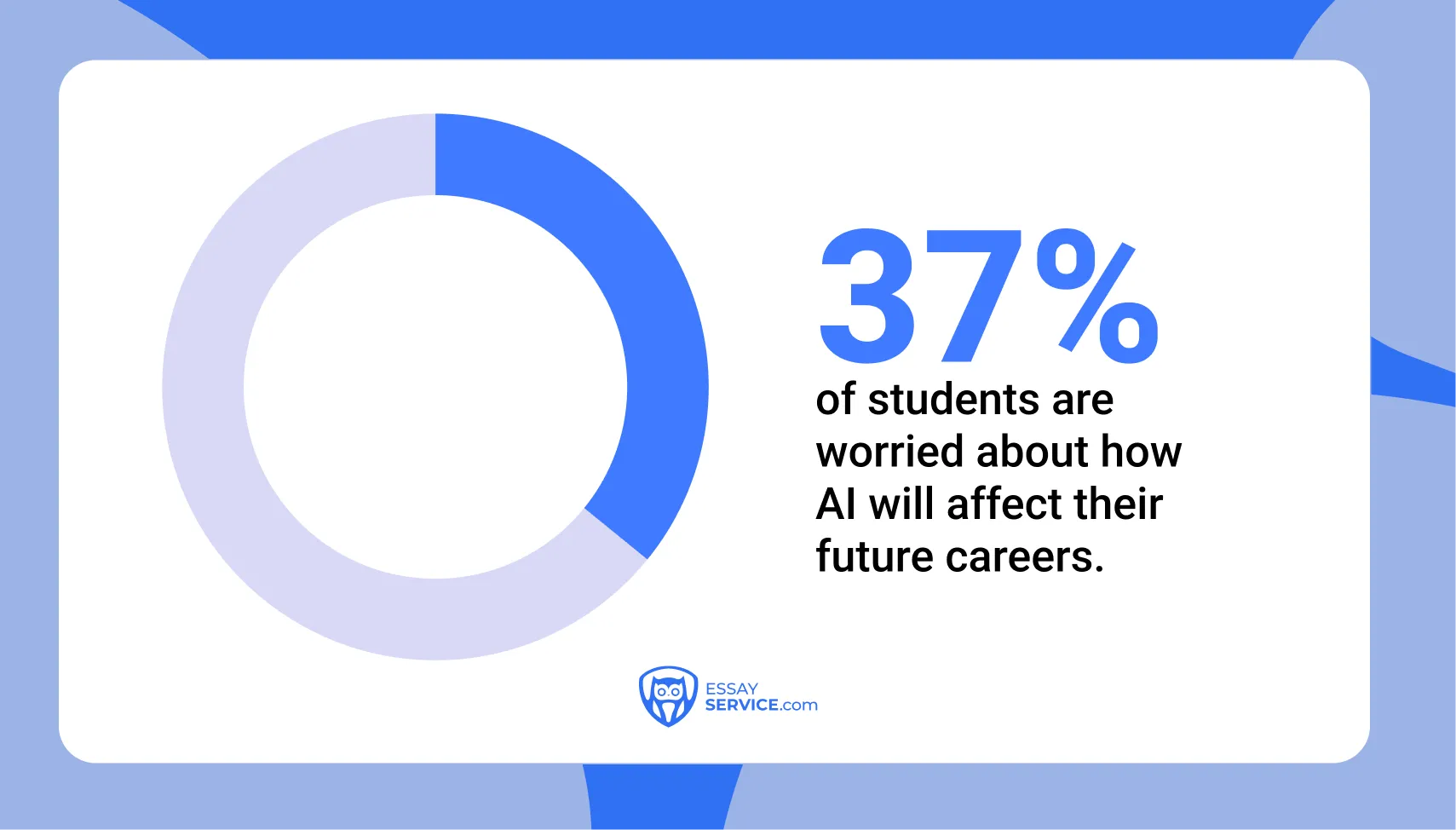
Polls also indicate that roughly 75% of knowledge workers are using Artificial Intelligence now, much to their surprise, without any formal AI training. They’re adopting these new technologies at such a rapid pace that students are afraid of being left behind, especially since they haven’t had the opportunity to work with the tools or even complete hands-on work in class.
Which Jobs Are Facing the Biggest Risk
AI automation does not threaten all jobs equally. Occupations involving repetitive, rule-based tasks are the most exposed to AI. Here are the key statistics:
- 95% automation risk for data entry and administrative jobs.
- 80% automation risk for customer service roles.
- 65% automation risk for retail cashiers.
- 50% automation risk for manufacturing roles.
- 26% of jobs could be highly transformed by generative AI.
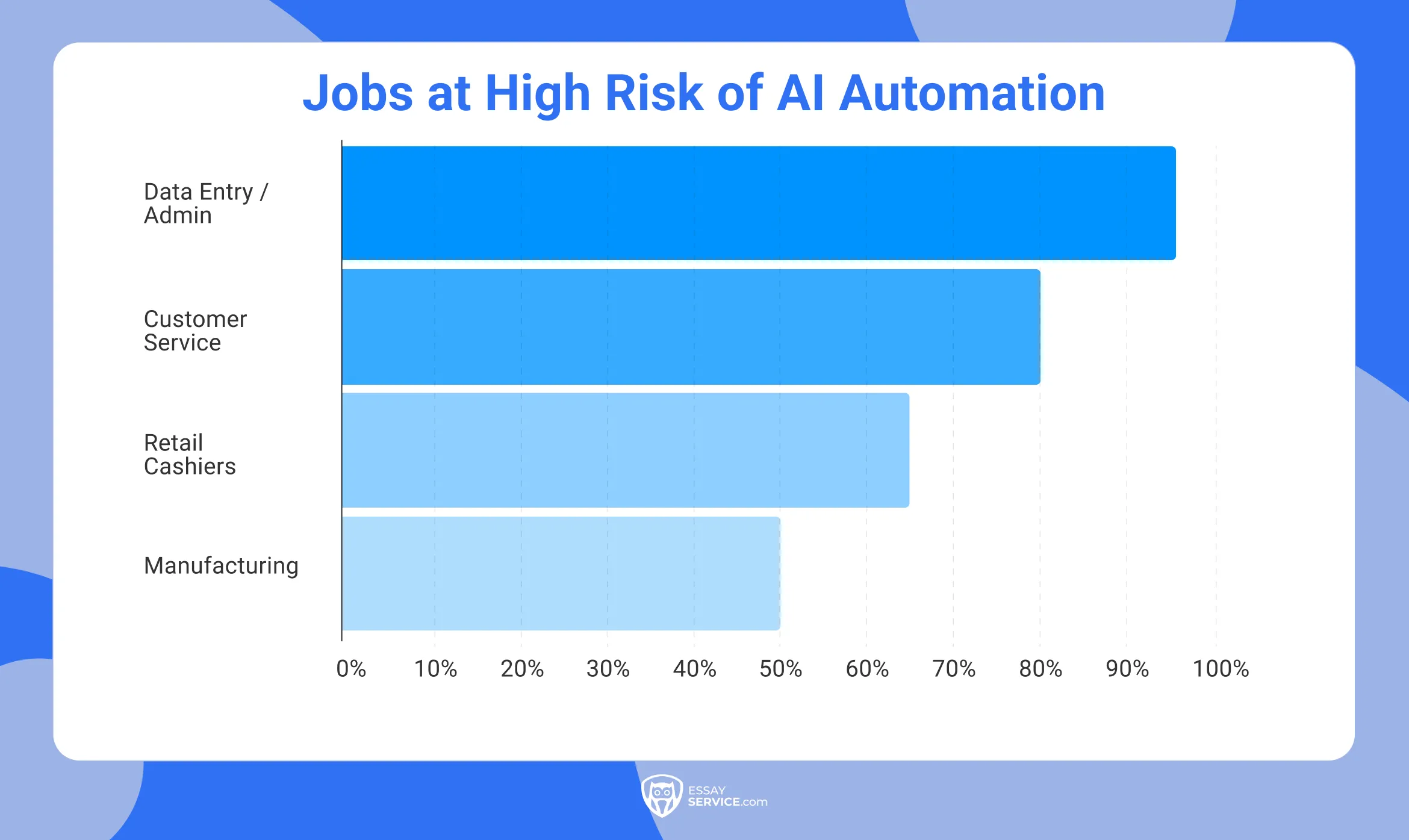
The BLS notes that new technologies often take years to spread and usually complement human labor. For example, automating call centers reduces basic queries but increases demand for skilled agents who handle complex issues. As jobs replaced by AI continue to rise, new roles are emerging for people who monitor systems, train algorithms, and ensure ethical use. Workers in at-risk positions are encouraged to retrain and build skills that align with these changes.
Industries that rely on both digital tasks and physical presence, such as construction, nursing, and hospitality, are less affected by AI, since robots still struggle with skilled movements and human interaction. So, AI technology is beneficial because it releases workers from monotonous tasks while creating demand for oversight and problem-solving skills.
Which Jobs Are Growing
Although some occupations are at risk of being replaced by machines, many are rapidly expanding due to Artificial Intelligence integration or demographic shifts.
- Over 50% job growth projected for PCA in healthcare practitioners by 2033.
- 44% growth for wind turbine technicians.
- 22% growth for solar photovoltaic installers.
- 32% growth for information security analysts.
- 15% growth for software developers and QA analysts from 2024–2034.
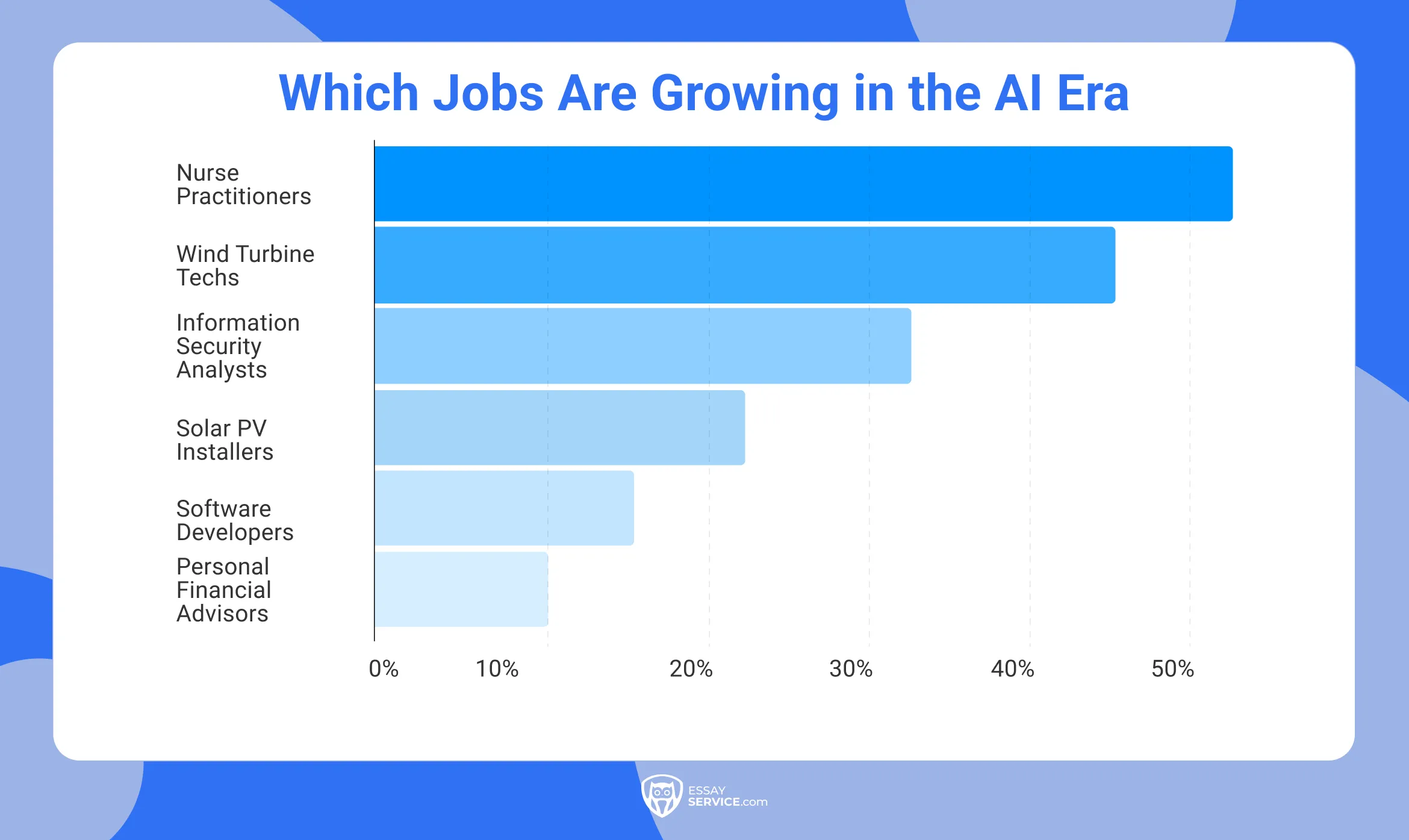
As we move deeper into the AI era, business leaders note that AI creates entirely new careers. Future jobs created by AI include prompt engineers, AI ethicists, data curators, and model explainers. Industries with the highest AI adoption rates have seen revenue per employee grow three times faster and wages rise twice as quickly compared with less-exposed sectors. As a result, workers with AI skills have received a 56% pay premium, compared to a 25% premium the previous year. This net gain is a clear indication that increasing employee demand in the market for human expertise complements machine intelligence.
AI and Career Anxiety: Factors That Drive Fear
Worrying about losing jobs to AI is common. Around 30% of employees fear being replaced, and 13.7% of U.S. workers say they have already lost a job to automation. Labor trends show both risk and opportunity. By 2030, about 170 million new jobs could be created, while 92 million might disappear due to automation.
Students feel this pressure early. Many believe that entry-level jobs will shrink as employers cut costs through AI. Rising living expenses and student loans deepen the fear of an unstable future. Media stories about AI taking over jobs only make it worse, even though most AI tools are designed to support workers, not replace them.
The best response to the impact of AI on jobs is preparation and clarity. Studies show AI boosts productivity by an average of 66%. Programming work improves by 126%, and customer service by 35%. When repetitive tasks are automated, people gain more time for creative and human-centered work. Clear communication from employers about AI’s purpose and training options helps reduce uncertainty and builds trust.
Meanwhile, if you are planning long-term goals, read the career goals essay guide by EssayService.
Essential Skills for Building a Future-Ready Career
The fastest way to face uncertainty is through skill development. AI is changing job roles quickly. Tasks in AI-related fields evolve 66% faster than others. Workers with AI knowledge earn 56% more than their peers. Lifelong learning is no longer optional.
To stay competitive, focus on two areas.
Technical skills:
- Data analysis
- Programming and machine learning
- Cybersecurity and prompt writing
- Knowledge of large language models
Human skills:
- Critical thinking
- Communication and empathy
- Adaptability and teamwork
- Ethical judgment
New career paths are opening in AI policy, ethics, and governance. People who understand both technology and regulation will be in high demand.
Traditional education still helps, but self-learning matters more now. Webinars, short courses, and online boot camps offer practical skills and direct experience with AI tools. Continuous learning keeps you employable and ready for change.
Final Words
AI is reshaping the job market, not erasing it. Routine and clerical roles face the highest risk of automation, but new jobs are rising in healthcare, renewable energy, and software development. Younger workers and women face greater exposure to automation, yet upskilling and adapting to AI-driven tools often leads to better pay and stronger career growth.
When studies, deadlines, or job stress build up, steady guidance helps. Our essay service provides reliable support to help you stay confident in your studies and prepared in an AI-driven world.
Frequently Asked Questions
What Types of Jobs Will AI Affect the Most?
Automation could impact around 300 million jobs globally by 2030, or about 9% of total employment. In the U.S., nearly 30% of jobs could be automated, though most will change in structure rather than disappear.
How Many Jobs Will AI Replace by 2030?
Research suggests about 76,000 jobs will be lost to AI in 2025, equal to roughly 5% of total job losses. Many others are being reshaped instead of fully replaced.
How Many Jobs Has AI Replaced?
While some roles have declined, many sectors continue to grow. Jobs for nurse practitioners, renewable energy technicians, software developers, and financial advisors are increasing. New careers such as prompt engineers, AI ethicists, and data curators are also emerging.
What Are the Jobs of the Future?
Future work will depend on creativity, decision-making, and management. People with flexible thinking and problem-solving skills will earn more, while those in repetitive jobs should plan to retrain.
How Will Automation Affect Jobs in the Future?
AI will keep increasing efficiency and reducing repetitive work. It will also raise demand for workers skilled in oversight, ethics, and creative solutions. Those who learn to work with AI tools will stay competitive and earn higher wages.

Phil spends his working days teaching international trade. He contributes to our blog as a freelancer, leveraging his experience with MBA students to advise on academic writing, studying abroad, and securing funds.
- U.S. Bureau of Labor Statistics. (2024, April 12). Personal financial advisors. Occupational Outlook Handbook. https://www.bls.gov/ooh/business-and-financial/personal-financial-advisors.htm
- Harvard Gazette. (2025, February 18). Is AI already shaking up the labor market? Harvard University. https://news.harvard.edu/gazette/story/2025/02/is-ai-already-shaking-up-labor-market-a-i-artificial-intelligence/
- World Economic Forum. (025). The future of jobs report 2025. World Economic Forum. https://reports.weforum.org/docs/WEF_Future_of_Jobs_Report_2025.pdf
- Federal Reserve Bank of St. Louis. (2025, August). Is AI contributing to unemployment? Evidence from occupational variation. Federal Reserve Bank of St. Louis. https://www.stlouisfed.org/on-the-economy/2025/aug/is-ai-contributing-unemployment-evidence-occupational-variation
- PricewaterhouseCoopers (PwC). (2024). AI jobs barometer: How AI is reshaping work and productivity. PwC. https://www.pwc.com/gx/en/issues/artificial-intelligence/ai-jobs-barometer.html
New posts to your inbox
Your submission has been received!
